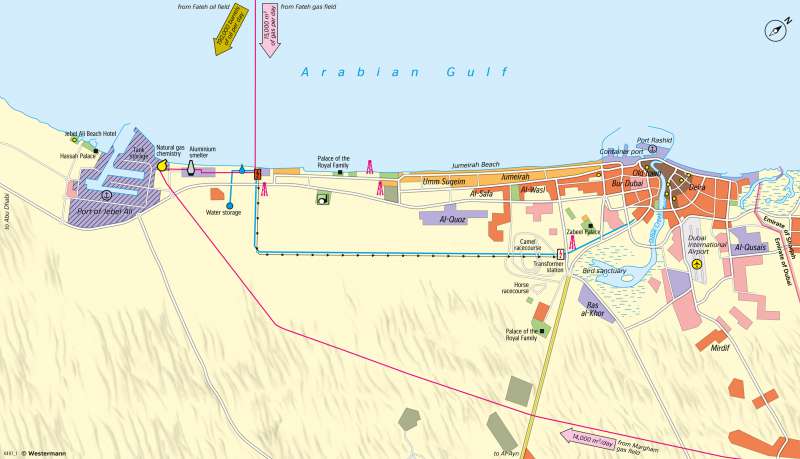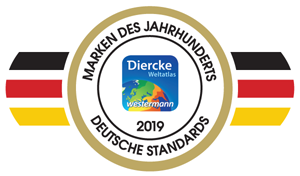Dubai - Urban development and urban sprawl
Economic development in the Middle East
978-3-14-100890-6 | Page 141 | Ill. 2

Overview
A landmark of Dubai, the capital of the emirate of the same name, is the residential area "Palm Jumeirah" in the shallow coastal waters off the city. The artificial island in the shape of a palm tree was hailed by investors in the early 2000s as the "eighth wonder of the world". It was only the first of several similarly ambitious construction projects in Dubai.
However, Dubai, which has hardly any oil reserves but has long been considered a Mecca of finance and real estate, was hit hard by the global financial crisis of 2008/2009. The demand for luxury real estate collapsed dramatically, several major projects such as the artificial islands "Deira Palm", "The World", "The Universe", "Jebel Ali Palm" and the new luxury district "Veneto" had to be shelved - at least for the time being. Today, the emirate is highly indebted. Nevertheless, due to the favourable economic development and the award of the Expo 2020 - which Dubai hopes will bring new impulses for infrastructure, real estate business and tourism - the prognosis for overcoming the debt crisis is favourable.
History until 1990
The Emirate of Dubai on the lower Persian Gulf is a small state with an area of about 4000 square kilometres, which is less than one tenth of the area of Lower Saxony. The territory consists of a 50 kilometre long coastal strip located along both sides of the Dubai Creek. To the east, a road leads through the desert hinterland to the inland exclave of Hatta, a once picturesque oasis in the Oman Mountains, now heavily dominated by hotel buildings and desert tourism.
Since its foundation around 1830, Dubai has been ruled by the Al Maktoum family (emirs). Since 1835, the emirate was under British protection. After the British withdrew, seven small states joined together in 1971 to form the "United Arab Emirates" (UAE). Due to their immense oil and gas reserves, they are now among the richest states worldwide.
In Dubai - along with Abu Dhabi, an economic centre of the Emirates - an unprecedented development programme began in the early 1980s. As a counterpart to Dubai Creek with Deira ("village"), the historical family seat of the Emir ("Shindagha") and Bur Dubai, the old port area, the port of Jebel Ali was created in the southwest. It consists of duty-free industrial and trading areas of the free trade zone (Jebel Ali Free Zone), in which more than 7,000 companies from the different sectors have settled since its founding in 1985. It includes around 100 of the companies on the "Fortune 500 List" (companies with the highest turnover worldwide).
To the north-east of the free trade zone, the DUBAL aluminium smelter was founded, which is now a world leader with a production capacity of over 1 million tonnes. Not far away, a seawater desalination plant was built, which was later complemented by three thermal power plants.
Several industrial and trading areas have been designated in the south of the city. Dubai International Airport, opened in 1960, was of little importance in the beginning and was served directly by only a few European airports in 1990. Thanks to an ambitious development plan, it was expanded in the following 25 years to become the third largest airport in the world in terms of passenger traffic. Today, numerous direct connections to European countries are the rule, no longer the exception.
Urban population
Dubai currently has a population of around 3.3 million, although their numbers fluctuate greatly because around 80 per cent of them are foreigners, many of whom are migrant workers. The migrant workers, mainly from South and Southeast Asia are employed on the city's large construction sites for very small wages. Their camps are hidden in industrial and trading areas, far away from tourists and shopping malls. NGOs like Amnesty International have repeatedly criticised the living and working conditions of migrant workers in the United Arab Emirates.
Water is a scarce commodity in the Emirates. The few natural sources are far from sufficient to meet the rapidly increasing demand. Therefore, fresh water in Dubai is mainly obtained through the energy-intensive desalination of seawater and then distributed via a main water pipeline, in gigantic quantities. Dubai's most famous golf course alone has a daily demand of 3.5 million litres of water. With an average consumption of 470 litres per capita per day, the emirate is the world leader in water consumption.
Development into a tourism metropolis since 1990
4 metres exactly half as high, is considered the world's tallest residential building.
The strategy of relying on tourism has paid off. With around 14 million tourists annually, Dubai is one of the most visited cities in the world and now generates significantly higher revenues from tourism than from the oil sector. Between 1990 and 2010, Dubai’s contribution to the country’s export was reduced from 50 to less than 5 percent.
To relieve the overcrowded roads, public transport was expanded with the installation of underground and elevated railways. In the southwest of the city, a new major airport, Al Maktoum International Airport, was built. Primarily, it is supposed to relieve Dubai International Airport, but, according to the planners, it will develop into a logistics and air freight hub between Europe and Asia and the largest airport in the world by 2025 - with 120 million passengers and a transfer of 12 million tonnes of air freight per year. (By comparison, Frankfurt/Main had around 71m passengers and 2m tonnes of air freight in 2019).




